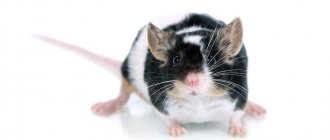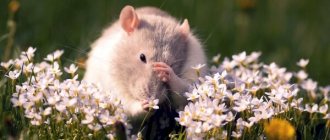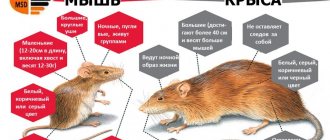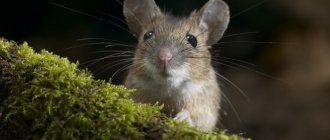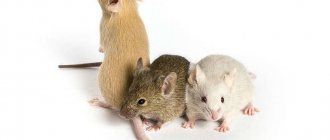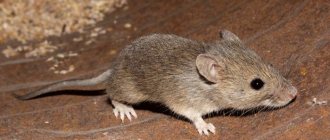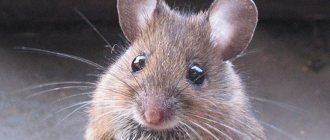When choosing a pet today, preference is increasingly given to such decorative types of rodents as satin mice. They are absolutely calm, friendly and quite unpretentious. However, this very gentle creature with unique fur can die due to hypothermia or extreme heat. And in order for a pet to delight you with its presence for a long time, you need to understand what its characteristics are and how to properly care for it.
Content
The color of mice can vary greatly depending on the breed. Starting from white albino mice (nicknamed “lab mice”), ending with completely black options.
When keeping mice, you should remember that, like other rodents, their teeth grow constantly and they need to grind down the excess. Most often, teeth are ground down by furniture, cage bars, and anything that gets on the tooth. Mouse teeth are not strong enough to chew through steel, but they are quite capable of ruining any wooden objects. Therefore, mice must be provided with material for grinding down their teeth (solid food, wooden sticks, etc.).
Contrary to popular belief, mice can live in the same apartment as cats, but even if a cat is accustomed to the sight of mice, sometimes its hunting instinct can kick in and the mouse’s lifespan will be significantly shortened. In addition, fear of a cat can cause disturbances in mice, which will shorten their life even without any effort on the part of the cat.
In general, it is possible to keep mice at home, even in an open cage, but you need to make sure that the second generation of mice does not crawl around the apartment. It is also necessary to remember about the short lifespan, which can become a serious problem for impressionable and sentimental people. Despite the fact that mice are pests in nature, at home they can be affectionate and tame animals that will bring many pleasant moments.
Read: 65
Origin story
Man first began to domesticate rodents even before our era, in the East. The breed of satin mouse was bred through selective breeding. Asia is considered to be its homeland, but the description was first given in the United States after an official exhibition in 1950 - this was the very first exhibition of domestic rodents in the world. After it, these events became very popular in the 50s of the 19th century. However, only rodents with an excellent pedigree could get on public display.
Did you know? In 1950, the first club of mouse lovers was created, which not only held exhibitions, but also set standards for various types of rodents.
Care and maintenance of domestic mice
There is nothing difficult about caring for and maintaining decorative mice, even for a child. The conditions of detention should be as follows:
- indoor air temperature – +20…+27 degrees;
- humidity – 55-65%;
- dim lighting;
- no draft.
Cage and filler
Before buying a cage, you need to decide how many mice will live there. For a family of 3-4 individuals, a dwelling measuring 60x50 cm is suitable. The height can be any, but not less than 40 cm. For one house mouse, a cage with dimensions of 40x30 cm is used.
Preference is given to designs made of metal gratings with a plastic removable tray. It’s good if it has high sides, then the filler won’t spill out. The door must close securely, otherwise the decorative mice will escape.
A thick layer of wood shavings is poured onto the bottom - at least 3-4 cm. Only natural materials can be used as bedding - pressed sawdust, crushed corn cobs. Cotton wool, rags, paper are not the best option, as they do not hold back unpleasant odors and quickly get wet.
Interior design of a mouse's home
It is recommended that pet mice have a resting house. You can make it yourself from scrap materials or buy it ready-made at a pet store. A little filler is poured inside so that mice can burrow into it when they are cold or scared.
In addition to the house, you will need a feeder and water bowl, as well as a running wheel to increase physical activity. It is better to give preference to a solid structure without holes. The tail can get stuck there while running, which can lead to injury. If there is enough space in the cage, it is worth placing pipes, tunnels and ladders inside. With their help, it is convenient to connect the first level with the second.
Hygiene
Cleaning the cage of a decorative rodent is done as the litter becomes dirty. If there is only one house mouse living there, the procedure is carried out once every 5-7 days, if there are several, more often. The old filler is thrown away and new filler is added. Every time during cleaning, all equipment is washed - drinking bowl, feeder, pipes and wheel. It is better to clean the tray with a soda solution and scald it with boiling water.
The fur of a house mouse also needs to be looked after. It becomes contaminated with feces and urine, and pieces of food stick to it. Even if the fur smells bad and looks untidy, the decorative rodent should not be bathed. Mice cannot swim and are very afraid of water, unlike domestic rats. Dirty fur can be cleaned in other ways - with a toothbrush, a damp cotton pad or a piece of soft cloth.
Bathing a house mouse in water is allowed in exceptional cases when the contamination cannot be removed in any other way or is life-threatening. To wash your pet you will need a deep bowl. No more than 2 cm of water is taken into it. The fur is gently wetted by hand, then detergent for rodents is applied, lathered and rinsed. After thorough rinsing, the pet mouse is wrapped in a towel and held in your arms for as long as possible so that it does not catch a cold.
Taming of ornamental rodents
A house mouse is easier to tame than a hamster. The main thing in this matter is consistency and regularity of communication.
After purchasing the decorative rodent, leave it alone for a day or two. During this time, he will adapt, inspect and sniff his new home. Next, you can begin to gradually tame the mouse:
You should approach the cage more often and talk to the rodent in a quiet and gentle voice. The next stage is getting used to the owner’s smell. To do this, you need to feed the mouse by hand through the grill. After a few days, you can try to open the door and give something tasty in the palm of your hand. The rodent will have to come and take the food on its own. Soon the house mouse will understand that the owner's hands do not pose a threat. She will begin to climb right into your palm and eat calmly
At such moments, you need to carefully stroke her back. At the final stage of taming, the decorative mouse will calmly allow you to pull yourself together. The main thing is not to scare her with sudden movements or loud noise.
To prevent a house mouse from going wild, you need to regularly communicate with it. If you don't pick it up for a long time, it will quickly wean itself off its owner.
Maintenance and care
You can keep a mouse at home in a fine-mesh metal cage, as well as in a special organic glass container with a lid. It is necessary because mice are excellent jumpers. The terrarium or cage must be spacious enough, since animals are very active and need movement. Strips of unpainted paper or shavings are used as bedding. A house (a jar, a box, a pot, etc.) is installed in the cage, in which the mice will arrange a nest, a drinking bowl, a feeder, a piece of chalk, as well as other devices for games. Stairs, levels, shelters, branches are suitable for this; it is also advisable to install a running wheel.
The terrarium or cage is placed as far as possible from windows, radiators, air conditioners and doors, since animals do not like temperature fluctuations, direct sunlight and drafts. The best air temperature is 20°C with an air humidity of 55%. Every day, garbage and leftover food are removed from the cage, and the feeders and drinking bowl are washed. The bedding is changed three times a week, at least once a month it is necessary to disinfect and completely clean the terrarium or cage. Mice feces have an unpleasant, pungent odor. At the same time, females smell much weaker than males.
In the terrarium, it is advisable to install pieces of large tree branches directly with the bark (birch, willow, rowan) so that the animals can grind their incisors on them. It must be taken into account that lilac is poisonous to these animals. You can also put wooden toys in the cage, with which the animal will play, grinding down its incisors. With well-organized housing, house mice do not need walks. If the animal does go out for a walk, then the place for its walks must be limited to the owner’s hands or a table. It must be remembered that various house plants are poisonous to mice, including aralia, yucca, Christmas star, kala, etc.
When keeping several animals at once, it is advisable to create same-sex groups: 2-3 males or 2-3 females living in a common cage get along well together. At the same time, those that originated from the same brood get along better. Newborn babies should not be picked up and their mother should not be disturbed.
Such mice are evening and nocturnal animals; they can disturb sleep with the noise and various sounds they create, although they generally adapt to the human regime.
Electric models
Beginners should pay attention to more innovative gadgets. They are definitely a little more expensive
But in this case, the price increase proportionally affects safety.
We are talking about a family of rechargeable machines equipped with a rotating head. They do not cut, but grind down the cornea. With this approach, it is almost impossible to harm a dog or cat by catching too much of a nail. The high rotation speed of the tip ensures fast operation, and the low noise level does not bother four-legged patients at all. Any beginner can easily cope with such a mechanism.
Price – 481 – 1,859 rubles.
Some models are equipped with 2-3 heads, suitable for dogs or cats of various breeds and age groups.
After all, the claws of a dwarf poodle are much more delicate than those of a German shepherd. The same applies to young kittens and adult cats - their paws need to be treated with different elements. So, when purchasing a tool for trimming claws, you should consider this nuance.
Cost – 567 – 1,189 rubles.
The final touch is the rotation speed of the device head.
It directly affects the quality of claw grinding. After all, it is necessary not only to cut off the ends, but also to polish the ends so that the sharp edges do not injure the delicate pads of the paws. This operation is best done in a more gentle mode at low speeds. So a machine with gear shifting will come in very handy in this case.
Price – 497 – 1,566 rubles.
I like it I don't like it
Types of decorative mice
Numerous varieties of Decorative mice differ in the type of coat and variations in color and color patterns. Different countries have their own national standards for varieties of Decorative Mice, which are used by judges during exhibitions and shows.
Short-haired mice
The hair of such a mouse is smooth to the touch, short and dense. The coat has a natural shine and lies close to the body, including the belly, groin, area around the front legs, and behind the ears. This type of coat is basic for all colors and patterns. Any of them is most easily recognized and looks brighter on the short-haired skin of a decorative mouse.
Satin Satin Mice
The name of the Satin Satin Mouse speaks for itself. Its coat has an increased shine, reminiscent of the smoothness of metal or satin fabric. The hairline shimmers in bright light. This effect is achieved due to the fact that the animal’s hair is empty inside, so it reflects light better. The hair is thick, dense, soft and silky to the touch.
Similar hair is found in all other decorative mice - Short-haired, Long-haired, Rosette, Rex, Hairless, etc. The satin mouse is larger than the usual decorative house mouse; the tail, in relation to the length of the body, is slightly larger than that of its ordinary relatives. The body proportions are almost the same, the ears are small and neat, the eyes are bright and shiny. The satin mouse comes from Asia.
Decorative Rex mice
This mouse is also called Astrex. You can easily recognize the decorative Rex mouse by its wavy fur with dense curls that are distributed throughout the body. The animal's whiskers are twisted and curled. The Rex coat type is found in other varieties of Ornamental Mouse. The Rex coat type is represented in four varieties of mice: Shorthair Rex and Shorthair Satin Rex, Longhair Rex and Longhair Satin Rex.
The most popular are the long-haired satin Rex mice. Their hairs are hollow and curl easily. The color of the animals can be any.
Abyssinian rosette mice
The animals got their name because they have areas of fur where the hairs change the direction of growth and curl into a funnel, forming a rosette. The Abyssinian rosette mouse has one or more such areas on each side. The sockets have a clearly defined center point. The shape is smooth, rounded. The Abyssinian coat can be of any length, as well as color.
Long-haired Angora mice
The Angora has long, smooth hair. The hairs are silky. These representatives of the mouse family have long antennae. Most often, breeders choose long-haired satin mice, whose hair is both fluffy, long-haired and shiny. Angora colors come in a variety of colors.
Long-haired Texel mice
The Texel mouse is easily recognized by its long-haired, curly coat with curls all over its body. The animal's whiskers are also curled. The hairline contains guard hairs that protrude beyond the normal coat.
Hairless Fancy mouse
Hairless mice are completely hairless. These hairless animals have wrinkled skin. The mustache can be short and curly. Some individuals have no antennae at all, as well as no fur. Among the behavioral habits, breeders note slowness.
Hairless mice are often kept together with their furry relatives to keep the hairless animals warmer.
Would you adopt a hairless rat? Poll Options are limited because JavaScript is disabled in your browser.
Fuzz downy mice
Fuzz downy mice got their name from the English. fuzz - fluff, fluff. They have curly fur, but differ from Rexes in that the curls are denser and steeper. The wool is similar to the skin of a young lamb. The length may vary. The hairs are sparse, short, guard hairs are absent. The fur is light and distributed unevenly over the body. This gives the impression that the animal is devoid of hair.
The tail is bare and covered with scales. The disadvantage of living together with Fuzz mice is the strong and specific smell, so the animals’ home must be cleaned regularly. Downy mice are a fairly new variety of Ornamental mice - a provisional standard (FMC) was approved in 2014.
Description of the satin mouse
Appearance
In appearance, satins resemble ordinary mice. The muzzle is elongated, the eyes are black, and the ears are large and round. The light whiskers are straight and long, the paws are bare with light pink skin. Coat color - from classic white and black to various cream, golden, gray, brown shades. They can be plain or spotted.
Learn about the breeds and care of gerbil mice.
Main characteristics
This breed of rodent is characterized by the following biological characteristics:
- body length 7.5–10 cm;
- weight 12–28 g;
- the tail is bare without hairs, elongated, wide at the base and gradually tapers towards the tip (there are tailless representatives of the species);
- the hind legs are five-toed, the front legs are four-toed;
- ears with hairline, translucent, large, widely spaced;
- life expectancy 2-3 years.
Incisors are constantly growing and need periodic grinding. There are different types of satin mice: satin, rex and others. Belonging to the breed is determined by the fur on the belly, especially in black individuals.
Important! Satins have weak immunity and are predisposed to tumors and viral diseases.
Behavior
The greatest activity is observed at night and in the morning. During the day they like to rest in secluded corners of the cage. They recognize the owner by smell and voice, and have high intelligence. The animal cannot sleep or remain awake for a long time. The period of activity is observed 15–20 times a day and lasts from 25 minutes to 1.5 hours.
Did you know? The word “mouse” comes from the ancient Indo-European “mush”, which means “thief”.
Content requirements
Keeping satin mice is not very expensive. The only thing you'll have to splurge on is the cage. Mice are small, but brave. They are active, love to run and jump, and willingly climb tunnels. And how they run in a wheel, you have to see it. Due to their size, they sometimes climb into the wheel together. One mouse runs in one direction, the other in the other. The wheel swings from side to side, and the satin mice begin to sort things out without leaving it.
Let's return to the topic at hand.
- The cage is two- or three-story. The presence of tunnels, ladders and wheels is required. The minimum dimensions of the cage are 40 x 50 x 35 centimeters.
- Little house. Now there are a great variety of houses for rodents. You can buy the cheapest one, the main thing is that the entrance to it is convenient for your pet.
- Filler. Some people advise using wood or sawdust. We recommend corn. The fact is that the woody one is very large. And it is very uncomfortable for a small mouse to walk on it. In addition, when wet it crumbles. This means that urine begins to evaporate. The impurities it contains are harmful to the health of the mouse. The sawdust begins to smell already on the second day after they are changed. If it is not possible to buy corn litter, cover the bottom of the cage with plain white paper.
- The simplest feeder. Take the smallest, plastic one.
- Buy a hanging drinking bowl. You can take it with a metal fastening, or you can give preference to a wire one. The latter is not particularly convenient, because the wire tends to break.
The cage is two- or three-story. The presence of tunnels, ladders and wheels is required. The minimum dimensions of the cage are 40 x 50 x 35 centimeters.
Little house. Now there are a great variety of houses for rodents. You can buy the cheapest one, the main thing is that the entrance to it is convenient for your pet.
Filler. Some people advise using wood or sawdust. We recommend corn. The fact is that the woody one is very large. And it is very uncomfortable for a small mouse to walk on it. In addition, when wet it crumbles. This means that urine begins to evaporate. The impurities it contains are harmful to the health of the mouse. The sawdust begins to smell already on the second day after they are changed. If it is not possible to buy corn litter, cover the bottom of the cage with plain white paper.
The simplest feeder. Take the smallest, plastic one.
Buy a hanging drinking bowl. You can take it with a metal fastening, or you can give preference to a wire one. The latter is not particularly convenient, because the wire tends to break.
Here is the basic list of needs for a satin decorative mouse. Now let's talk about how to care for her.
Owner reviews
The glossy mouse is a great pet. It can be easily purchased, unlike the satin curly mouse. It’s not that easy to get, and it costs an order of magnitude more than usual. The difference is in the coat - in curly it sticks out in all directions.
We got distracted again. Let's return to what the owners of these babies say. For the most part, the people are delighted. Loving owners speak of their pets as very smart and affectionate animals. Some breeders claim that a satin mouse is much better than a dog. It’s nice to watch them, the mice are real little “little creatures”. Most owners note that their pets are very clean: they eat in one corner of the cage, sleep in another, and go to the toilet in a third. Mice are pleasant to hold in your hands; they do not try to break free and run away. They know how to kiss. Very gentle animals.
After reading the reviews, I want to run to the pet store for a satin pet.
Features of feeding
The basis of the diet of the satin mouse is grain. Pet stores sell mixtures that include millet, barley, buckwheat, wheat, oats and seeds. A pet needs 1 teaspoon of food per day.
In addition to grains, you can give some vegetables and fruits:
- carrot;
- broccoli;
- cucumber;
- zucchini;
- cauliflower;
- apple.
In the summer, you can pamper your satin mouse with fresh herbs; this is a good source of vitamins and amino acids. Your pet will not refuse dandelion and plantain leaves. Once a week, the mouse is offered boiled poultry fillet.
Prohibited products include:
- sweets;
- pastries, bread;
- white cabbage, turnip;
- mushrooms;
- horseradish;
- garlic;
- bananas;
- citrus;
- dried fruits (they contain a lot of sugar);
- cheese;
- potato;
- chips, crackers, snacks;
- salty, fried, fatty foods from the human table.
Breeding
House mice become sexually mature at 30-35 days of age. In females, estrus begins; in males, a sign of maturation is the descent of the testes into the scrotum. It is recommended that females be mated for the first time upon reaching three months of age.
Effective mating is possible only during estrus, which occurs in females every 3-8 days and lasts from 4 to 20 hours. Pregnancy in house mice lasts 22 days.
Approximately in the middle of gestation, the female begins to build a house or nest from the litter in which the pups will be located after birth. She uses wood shavings, scraps of soft fabric, paper, and napkins as building materials.
It is important to ensure that all this is at the disposal of the pregnant female
There are from 5 to 9 mice in a litter. They are born naked, blind and deaf. The weight of a newborn mouse is 1-2 g.
Little mice develop quickly. On the third day they develop hearing, and on the fourth day their bodies are covered with soft fur. By the fifth day of life, their body weight doubles. Two weeks after birth, the eyes open. From this age, domestic mice begin to feed themselves. The young animals are weaned from their mother on the 21st-25th day.
To avoid uncontrolled reproduction, male domestic mice are separated from females.
Many people are not sure whether to get a pet mouse, because this animal has already earned a bad reputation. However, ornamental species of rodents make excellent pets - they are easy to care for, interesting to watch, mice are quickly tamed, and do not require much attention or high maintenance costs.
Reproduction
Baby mice are capable of producing up to 12 litters per year. Pregnancy lasts 20 days; after the birth of the mice, the young mother is again ready for fertilization.
Once the pups reach 30 days, it is advisable to separate them by gender. The fact is that at the age of five weeks, these long-eared comrades can become parents. Taking into account the fact that 7–12 babies are born in a litter, it would be time to open a mouse farm.
Spiny mouse
Decorative spiny mice as pets have become popular relatively recently. These rodents have captured the hearts of people. They are sociable and quickly get used to people, especially those who care for them. They are unpretentious in captivity and care. What is such an animal? The spiny mouse is a cross between a gerbil, a hedgehog and a jerboa. The eyes of these animals are large and beautiful. The whole body is covered with fluffy fur, and there are real needles on the back.
This feature is the reason why these decorative mice were called spiny mice. The body length is on average 10 cm, and the tail is 9 cm. The face of this rodent is very cute. The lower part of the mouse’s body is covered with white hair, and on top there are needles of yellow, dark sulfur or reddish-brown color.
It must be kept in a cage with sawdust placed at the bottom. They need to be changed when they become dirty.
You should put a house in the cage, the mice will rest in it. You should also place climbing shelves and ladders in the cage.
These rodents need to be given branches of deciduous trees. There are no special features regarding nutrition. They eat everything that other decorative mice do.
Advantages and disadvantages of content
The positive aspects when choosing Japanese dwarf mice as pets are:
- beautiful color;
- their sociable and friendly disposition;
- ease of care;
- weak specific odor (especially in females);
- ability to tame.
However there are some disadvantages:
- small size, due to which animals can run and hide. Finding pets can be quite difficult. For this reason, many rodents also die due to the carelessness of their owners;
- the presence of a faint, but still noticeable odor;
- increased activity of mice at night. Therefore, it is not advisable to install a home with animals in the bedroom;
- short life expectancy (2–2.5 years).
We bring to your attention options for names for mice boys and girls.
However, despite all the “cons,” they will be a real joy for the owners of these cute little animals. Observing the life of these inquisitive and active animals, taming them, everyone will receive undoubted pleasure.
House mouse, how to choose the right one
Rodents are quite easy to keep at home. They do not require much attention from their owners and easily make contact with people, which makes decorative mice very popular pets.
When choosing a mouse, pay attention to the following nuances:
- teeth should be white and straight;
- the animal's eyes should be shiny and moist;
- the rodent must move actively and have a good appetite;
- there should be no bald spots on the skin;
- There is no unpleasant discharge from the eyes and nose.
The average lifespan of mice is 3-4 years, so choose an animal no older than 12 months. The mouse is a collective animal, and it is better to have several animals at once
This is especially important if the owner spends a lot of time at work. But you should not have several males in one cage, as this can lead to conflicts
Those who plan to breed mice on their own should know that until mating, males should be kept separate from females.
The main difference between wild animals and ornamental animals is safety. Wild rodents are carriers of various diseases, which makes them undesirable for domestication. When buying a mouse in a specialized store or at an exhibition, you can be sure that the animal has been vaccinated. In addition, when trying to tame a wild animal, you should remember that at first the mouse will be afraid and will not make contact with humans.
Types of house mice
House mice are popular pets, so breeders have created many subspecies of these rodents. The main differences between different breeds of mice are the quality of their fur, by which they are distinguished. The main characteristics are as follows:
- short-haired;
- medium-haired;
- long-haired;
- naked.
The following are added to these characteristics:
- Rex - wavy coat;
- Texel – thick long wool;
- Rosette mouse - the fur has different growth directions: from head to tail, and from tail to head. Where the hairs meet, a ridge or rosette is formed. The minimum number of such rosettes on an animal’s skin is 2, on each side of the body;
- Satin mouse - the fur of these rodents is very smooth and has a metallic tint.
In addition, breeds are divided according to color type:
- plain;
- broken marked - with dark spots;
- ribbon - white paws and dark skin, with one light spot;
- white rump - the main color is dark, and the back of the body, including the paws and tail, are light in color.
All types of these mice have the same life expectancy - 2-3 years. The animals weigh about 80-100 grams. and have a body length of 8-10 cm. In males, these figures are always greater. The breed does not in any way affect the character and habits of rodents.
Care and maintenance of mice at home
To keep domestic mice, you need to purchase a cage that must have:
- drinking bowl;
- feeder;
- house.
In addition, it is worth adding to the cage various ladders, wheels like for hamsters, and other devices that allow the pet to spend time actively. The size of the cage depends on the space in the apartment, but the larger it is, the better.
Mice are omnivores, but it is worth remembering that your pet’s diet must be balanced and meet the following requirements:
- grain is the basis of the diet;
- you should alternate between dry and juicy foods;
- use vitamins once every six months;
- Don't forget to give your mouse protein food.
Breeds of rats
Sphynx rat
Curly rat
Tailless rat
Female or male?
Implicit external differences between rats of different sexes nevertheless give rise to obvious differences in behavior.
Males are suitable for an owner who is going to take his little friend with him everywhere, since male rats become more attached and are calmer. True, their disadvantage is uncleanliness or, more simply, a natural need to mark territory.
Females, as in the human world, look after themselves and the surrounding territory, but will not sit on your shoulder or in your pocket, preferring freedom of action.
Place of purchase.
You must buy an animal from a trusted place with a good reputation and all the documents and certificates for the animal. Here it is better to play it safe than to bring an unknown infection into your apartment.
How to choose a healthy animal.
A healthy baby rat is inquisitive - this is its main quality and the criterion by which you should choose an animal in a store. The animal, which became interested in the hand brought to the cage, calmly came up to sniff and communicate, demonstrating the most natural behavior for a healthy individual. Lethargic, half-asleep animals or, on the contrary, overly excited animals should not inspire confidence in buyers. When purchased, the rat should be between a month and a half old - not too young to have already acquired all the skills necessary for life from its mother, but not too old to quickly get used to its new owner.
When you first examine a rat in a store, there should be nothing alarming. Namely, it should not be:
- damage to the paws, tail or other parts of the body;
- inflammation, bald spots or parasites on the skin and coat;
- discharge from the eyes, nose or ears;
- dirt on the anus (this would mean diarrhea, which is difficult to cure in rats);
- sneezing or uneven breathing, indicating a cold.
If, when purchasing, there is at least something alarming about the appearance of the rat, you should not buy it, especially out of pity, since the consequences of such a choice can be the most disastrous.
Breeding
Only breeders should breed gerbils. In addition to the difficulties that may arise during and after pregnancy, there is the problem of what to do with the numerous offspring
Equally important, there are not many veterinarians who specialize in small rodents in most populated areas. Therefore, it is very likely that you will not be able to provide care for the rodent in case of complications
It is interesting to read about keeping and breeding chinchillas as a business.
Mating
The concept of mating is not very applicable to gerbils - primarily because sexually mature individuals, being in the same cage, will mate naturally in the near future. For gerbils, this is a grandiose event in terms of volume of noise with chasing each other around the cage, intense rustling and stamping of feet.
Pregnancy and childbirth
There are many different signs of pregnancy, but not all of them are noticeable at the initial stage. Accordingly, you need to remember that animals can reproduce from 3 months of age. And if a female of this age has been in contact with a male, then most likely she is pregnant.
Signs of pregnancy:
- the lower half of their body has become much larger than the upper, and gradually the mouse takes on the shape of a pear;
- the mouse is gaining weight;
- she began to form a nest.
Pregnancy usually lasts from 21 to 25 days. During this time, the female's behavior will change. She will become more wary and begin to drive others away from her nest. During childbirth, she does not need human help. A mouse will give birth to 3–7 babies at a time. Their mother will feed them for a month.
Important! If you don't intend to breed gerbils year-round, it's important to consider that, like many other rodents, they are ready to mate again the same day their offspring are born.
Gerbils are born without hair and with their eyes closed. The eyes will open on the 18th day, at the same time the teeth will appear. Toddlers almost immediately begin to sharpen them, trying to chew cardboard, sawdust and pieces of food. But at this stage they depend on mother's milk. They are weaned approximately 4 weeks after birth and transferred to solid food. They can be separated from their mother when they are 6 weeks old.
How to care for little mice
At first, babies cannot regulate their body temperature, so it is important that the mother is present and that she maintains the correct temperature in the nest. The mouse also performs the rest of its grooming on its own.
It is useful to know how many years decorative house mice live.
If you notice that a gerbil is kicking or moving babies, then this is completely normal behavior for them and does not require the intervention of their owners. It does not harm babies. You may also notice that the male gerbil also takes care of his offspring. He keeps the nest clean and tidy, and when curious babies start crawling, he collects them back into the nest.
Bottle with drinker
Such an accessory will come in handy during street walks. It does not take up much space, weighs little and does not hinder movement. But you can offer the dog to quench his thirst at any time, and not wait until he starts drinking from a dirty puddle or lake overgrown with mud.
The device consists of a water container and a bowl equipped with a dispenser button. It allows you to release as much liquid from the bottle as the animal needs to quench its thirst. Sold in two volume options - 350 and 550 milliliters.
Price – 475 – 584 rub.
Another model of the same device has a folding shape, which makes it easier to carry. The transformer connects the bowl and the bottle, securely fixing them in such a compact state. The durable polymer material has good shockproof properties and can even resist dog teeth. True, this struggle will not be long and - if the owner is careless - then all the liquid will end up on the ground.
Volume 250 ml.
Cost – 133 – 148 rubles.
I like1I don't like
White house (laboratory) mouse
These rodents have long since lost their wild nature. Recently, they are very often found among people as pets. Their mass maintenance began about 125 years ago. These rodents are sociable and unpretentious in care.
It is best for a white mouse to get used to a person if you purchase a month-old rodent. After purchasing it, you need to pick it up and play with it more often. These rodents are highly trainable.
Feeding is not difficult, they eat a variety of rodent foods. The white mouse eats greens, vegetables, and cereals. Never give your rodents fried or fatty foods. It is useful to supplement the diet with mealworms or other invertebrates.
For growing incisors, you need to add twigs of shrubs or stone fruit trees and crackers to the diet of young animals.
The duration of pregnancy in a rodent of this species is approximately twenty days. The female brings about seven babies, although there are more. A mouse can give birth to about ten litters per year.
Rodents must live in a cage. There must be a house in it. It is also advisable to install a wheel or additional accessories for games. The optimal temperature for keeping is twenty degrees.
Distribution in nature
Satins are widespread in the wild almost everywhere, especially in forests. However, the main habitat is in the United States of America. They do not live only in Antarctica, the Far North and high in the mountains, because they are not able to survive at low air temperatures. They like to settle near human habitations, especially in warehouses and barns, where there is a sufficient amount of grain.
Description of domestic decorative mice
Decorative mice are small and very cute pets. There are different types of these rodents, among which you will definitely find your favorite.
Appearance
These animals are small long-tailed rodents. As a rule, their body length does not exceed 10 cm. Their weight can be 12–30 g. Breeders have worked for many years to develop different types of mice.
Rodents can have different types of fur:
- curly;
- long;
- short;
- satin;
- bald.
House mice are also divided into:
- short-tailed;
- long-tailed
If we talk about the color of these rodents, they can be divided into the following groups:
- single-color (brown, black, white, gray, etc.);
- spotted (striped, with colored specks, etc.);
- multi-colored (gray-blue, gray-silver, as well as colors typical of chinchillas, sables, Persian cats, etc.).
Did you know? Mice's joints are similar in structure to those of humans. The number of parts they consist of is the same as that of humans.
Characteristics
Homemade decorative mice are ideal for those people who spend little time at home, cannot pay much attention to the animal, but really want to have a pet. These rodents do not require training, regular walking or educational processes.
Mice quickly get used to a new place, adaptation is painless for the animal. If you treat your pet with care, it becomes tame. Over time, he begins to recognize his owner. Rodents lead an active lifestyle. As a rule, this happens at night; mice sleep during the day. They are cheerful and rarely give up playing. These pets live on average 2 years. Life expectancy depends on the conditions of their detention.
Read with this
- Tiny little mouse
- Differences between a mouse and a rat: differences between adults, a mouse and a baby rat
- Spiny mouse
- Mouse bait in a mousetrap
- How do decorative mice differ from wild mice, and how to properly keep them at home?
- How to toilet train a dog using a diaper
- Everything you need to know about caring for budgies at home
- Reinforcement learning in machine learning
- Can your dog swim? Why Some Dog Breeds Can't Swim - Tips for Pets - 2020
- How to stop a dog from biting
